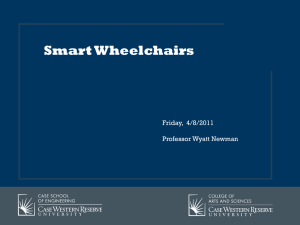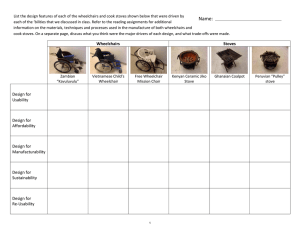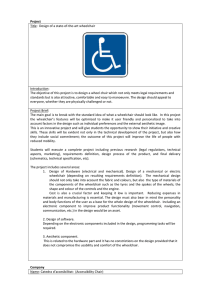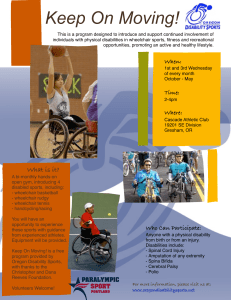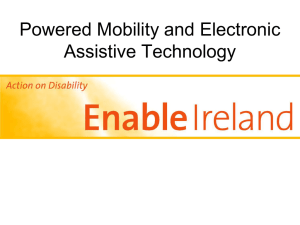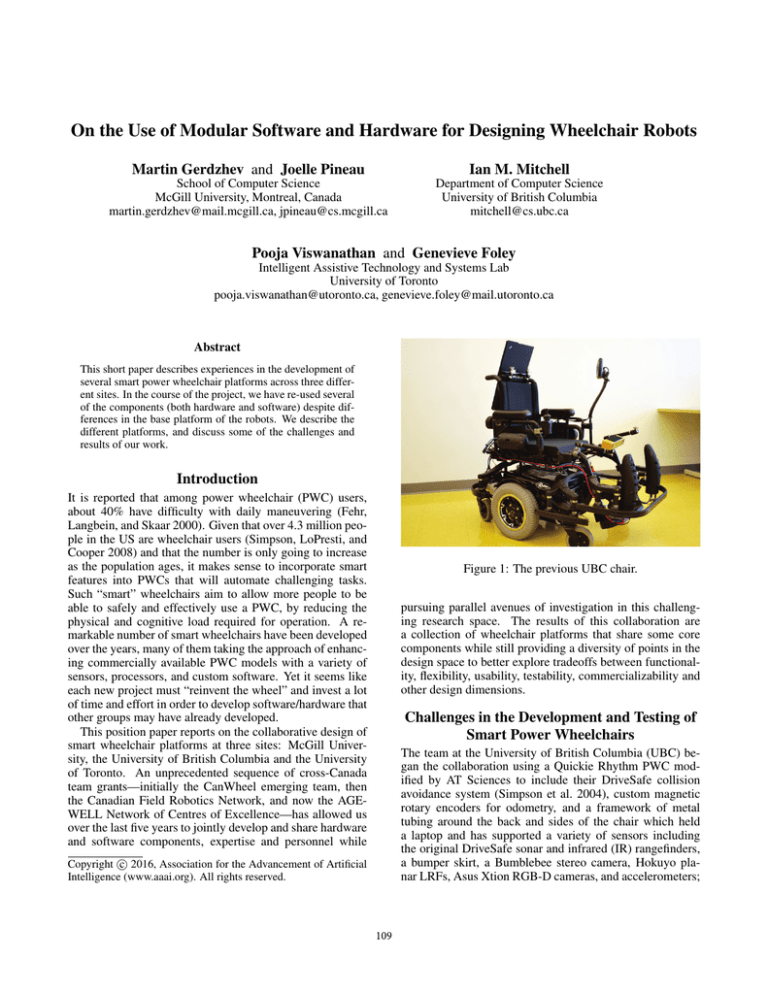
On the Use of Modular Software and Hardware for Designing Wheelchair Robots
Martin Gerdzhev and Joelle Pineau
Ian M. Mitchell
School of Computer Science
McGill University, Montreal, Canada
martin.gerdzhev@mail.mcgill.ca, jpineau@cs.mcgill.ca
Department of Computer Science
University of British Columbia
mitchell@cs.ubc.ca
Pooja Viswanathan and Genevieve Foley
Intelligent Assistive Technology and Systems Lab
University of Toronto
pooja.viswanathan@utoronto.ca, genevieve.foley@mail.utoronto.ca
Abstract
This short paper describes experiences in the development of
several smart power wheelchair platforms across three different sites. In the course of the project, we have re-used several
of the components (both hardware and software) despite differences in the base platform of the robots. We describe the
different platforms, and discuss some of the challenges and
results of our work.
Introduction
It is reported that among power wheelchair (PWC) users,
about 40% have difficulty with daily maneuvering (Fehr,
Langbein, and Skaar 2000). Given that over 4.3 million people in the US are wheelchair users (Simpson, LoPresti, and
Cooper 2008) and that the number is only going to increase
as the population ages, it makes sense to incorporate smart
features into PWCs that will automate challenging tasks.
Such “smart” wheelchairs aim to allow more people to be
able to safely and effectively use a PWC, by reducing the
physical and cognitive load required for operation. A remarkable number of smart wheelchairs have been developed
over the years, many of them taking the approach of enhancing commercially available PWC models with a variety of
sensors, processors, and custom software. Yet it seems like
each new project must “reinvent the wheel” and invest a lot
of time and effort in order to develop software/hardware that
other groups may have already developed.
This position paper reports on the collaborative design of
smart wheelchair platforms at three sites: McGill University, the University of British Columbia and the University
of Toronto. An unprecedented sequence of cross-Canada
team grants—initially the CanWheel emerging team, then
the Canadian Field Robotics Network, and now the AGEWELL Network of Centres of Excellence—has allowed us
over the last five years to jointly develop and share hardware
and software components, expertise and personnel while
Figure 1: The previous UBC chair.
pursuing parallel avenues of investigation in this challenging research space. The results of this collaboration are
a collection of wheelchair platforms that share some core
components while still providing a diversity of points in the
design space to better explore tradeoffs between functionality, flexibility, usability, testability, commercializability and
other design dimensions.
Challenges in the Development and Testing of
Smart Power Wheelchairs
The team at the University of British Columbia (UBC) began the collaboration using a Quickie Rhythm PWC modified by AT Sciences to include their DriveSafe collision
avoidance system (Simpson et al. 2004), custom magnetic
rotary encoders for odometry, and a framework of metal
tubing around the back and sides of the chair which held
a laptop and has supported a variety of sensors including
the original DriveSafe sonar and infrared (IR) rangefinders,
a bumper skirt, a Bumblebee stereo camera, Hokuyo planar LRFs, Asus Xtion RGB-D cameras, and accelerometers;
c 2016, Association for the Advancement of Artificial
Copyright Intelligence (www.aaai.org). All rights reserved.
109
figure 1 shows a configuration with the first three mounted.
In 2013 UBC and the University of Toronto jointly conducted a user study with 10 long-term care residents with
mild-to-moderate cognitive impairment in the Greater Vancouver Area (Mitchell et al. 2014; Viswanathan et al. 2014).
We learned a number of important lessons while conducting this study on (a considerably simplified configuration
of) the AT Sciences PWC. First and foremost, the seating
component is a critical aspect of testing with the target population. The bare-bones seat supplied with the chair was
fine for (skinny) grad students, but we were as likely to get
a mobility impaired older adult into that chair as onto a unicycle. We were fortunate to get a salvaged power tilt unit
and wider seat through contacts with a local vendor, which
facilitated ceiling-lift transfers of participants into the chair.
While only minor further modifications were required for
each study participant (for example, shifting the joystick to
match the participant’s dominant hand, moving one participant’s backrest from her own chair to the study chair), even
this seating configuration could not accommodate users with
more complex needs. Additionally, the availability of a single study chair meant that only one participant could test
the system at a time, adding further scheduling constraints
and increasing the overall time required to complete the user
study. Finally, mounting and wiring sensors was a challenge:
sturdy locations with good fields of view inevitably block access to the seat and are an aesthetic nightmare; for example,
consider that the configuration shown in figure 1 has 360◦
sonar, IR and bumper skirt coverage, an excellent forward
stereo vision view and an easily accessed control laptop, but
in order to sit down a user must thread their legs carefully
between the sensor pods and then is at constant risk of bumping them or the laptop while operating the chair. When performing user studies it may be hard to distinguish between
opinions driven by core performance and those driven by inconvenient or ugly appearance.
Although the user study was successfully completed with
this platform, it required some rather obscure CanBUS
drivers; by late 2014 we were limping along with a two year
old disk image and could not get the hardware operational
with newer versions of Ubuntu and ROS. When some electronics in the PWC base and the AT Science custom controller failed, we were unable to source replacements for either due to the age of the system. It thus became imperative
to develop a new modular system that would be compatible
with available and future commercial PWCs.
of Curtiss-Wright) which allows an external joystick to be
connected via an interface variously called the Omni+, RNet Omni or R-Net Input/Output module. Even with this
commonality, the motor controller’s interface remains proprietary and a reverse engineered joystick emulation is our
only means of motion control.
The board that we built to interact with the motor controller incorporates a standard off the shelf Arduino with a
custom designed shield. The Arduino’s standard USB interface is used to communicate through ROS to a laptop,
while the shield has ports for the Curtiss-Wright module
and a PWC joystick. This combination allows us to take
input from the user, route it through ROS nodes on the laptop to record and potentially modify that input, and then deliver it to the motor controller. Because there is no mechanism for feedback from the PWC base, the shield also provides a port to capture odometry data from custom designed
and mounted wheel encoders. Unfortunately, joystick commands do not map well (or even consistently) to the linear
and angular velocity commands generated by standard ROS
libraries. Where available, feedback from the odometry has
enabled design of a PID feedback loop that considerably improves linear and angular velocity control; however, such
odometry is not always available and even with it control
is imperfect due to the black box nature of the proprietary
motor controller into which the joystick signals are fed.
Nevertheless, this board has been successfully incorporated onto six PWCs in the three groups, with only minor tweaks of parameters to account for different electrical
and mechanical profiles among the four different commercial models represented. Currently we are working on algorithms that will further refine the joystick control signal with
a goal of achieving consistent motion behaviour among the
various models of PWCs.
Modular Software Development
With the emergence of ROS the development of modular
code that can be ported from one system to another has become significantly easier. There exist drivers and ROS interfaces for the majority of important robotics sensors—such as laser range scanners, 3D cameras, IMUs—that publish standard messages for use in other packages. External libraries like OpenCV and PCL can also be used seamlessly. This effectively allows for building software that is
abstracted from the specific hardware, and is only dependent
on whether the correct message type is available.
In the course of this project, we have developed several
modules that can be used across platforms.
• Module for people detection and tracking from planar
laser scans
• Module for detection of tables and ideal docking locations
• Remote control module
• Parallel parking module
• Back-in parking module
• Wall following module
• Module for basic navigational commands with obstacle
avoidance (forward/backward motion and turning)
Modular Design of Smart Power Wheelchairs
There are many different brands and models of PWCs on
the market that can be equipped with a variety of interfaces,
seating, drive configurations and other customizations, so it
is important to be able to abstract away as many of the hardware differences as possible, and develop add-on modules
that are independent of the type of wheelchair used. One
major challenge we have encountered (across all platforms)
is the interface between our added on-board computer and
the original motor controller of each PWC. Somewhat fortunately several brands of PWC use the same kind of motor
controller (originally developed by PG Drives and now part
110
Figure 2: The Quickie Freestyle Smart Wheelchair
Figure 3: The Quickie S646 Smart Wheelchair
• GUI module for utilizing the common user commands
The only minor issue getting the McGill Arduino controller
board operational with the Rnet Omni controller modules
was the manual retuning of a few parameters, although it is
not yet clear whether that was necessary due to fundamental
differences in the PWC models or manufacturing variance
in the joysticks and/or drive electronics. Thanks to the new
board, we were quickly able to port and then update our core
control software to modern versions of ROS. The chairs can
be remotely controlled, but are not yet autonomously operational as we are currently designing an aesthetically minimalist mounting frame for the sensors and are awaiting an
opportunity to install odometers to improve the accuracy of
autonomous velocity control.
• Module for merging input from multiple laser scanners
into a single message that can be easily used for mapping
and navigation
ROS makes the creation and sharing of modules easy.
Each module in ROS is a package that can contain multiple executables, custom libraries that can be reused in other
packages, and a plug-in system is available for convenience.
ROS follows the publish/subscribe design pattern which allows modules to subscribe to topics that they are interested
in, and to publish messages to topics which in turn can be
useful for other modules. This loose coupling lends itself
very well to mix and match designs.
The University of Toronto platform
Our Smart Wheelchairs
The team at the University of Toronto had an old, donated
Quickie P200 and a newer Pride Quantum 6000z. We
stripped these wheelchairs of their controllers and installed
new Rnet controllers instead, along with Rnet Input/Output
modules. Sensors include Microsoft XBOX Kinect and
Asus Xtion RGB-D cameras, ZX distance and gesture sensors by XYZ Interactive, and an IMU. Since our wheelchairs
do not have built-in encoders, we will likely use custom
magnetic wheel-encoders, similar to those built at other
sites. After slight tuning of a parameter due to differences
in our joysticks, we were able to use the McGill Arduino
controller board as is, along with the Rnet I/O module, to
send drive commands to the wheelchair. We also added on a
bluetooth module for remote wheelchair control. Integration
of the modular hardware and software components with our
ROS modules is currently underway.
The McGill SmartWheeler platforms
The team at McGill University in Montreal has built two different smart wheelchairs – a Sunrise Quickie Freestyle (Figure 2) and a Sunrise Quickie S646 (Figure 3). Both models are equipped with laser range-scanners, an Asus Xtion
RGB-D Camera, custom magnetic wheel-encoders, IMU,
GPS, touch screen, remote control joystick, and WiFi connectivity. The Freestyle model has two SICK LMS100 planar laser range-scanners (one facing forward and one facing
backward), while the S646 Model has three Hokuyo UHG
planar laser range-scanners (one in the back and two on the
sides) as well as multiple sonars (to detect transparent surfaces like glass that are common in malls). Both wheelchairs
use the custom Arduino controller board with an Omni+
module in order to send control commands from ROS.
Evaluation of Smart PWCs
The UBC platform
The UBC platforms consist of a pair of Permobil M300
bases with power tilt seats and width adjustable cushions.
We have discarded the IR, sonar and bump sensors from
the older platform, and are currently using Asus Xtion Pro
RGB-D cameras (instead of stereo) and/or Hokuyo LRFs.
With the modular hardware and software components we
have developed, we are now able to not only reduce the time
it takes to develop new algorithms and functionality by reusing ROS modules, but also replicate our systems across
multiple wheelchair bases fast and easily, allowing us to
111
conduct user trials across sites and at a larger scale. In addition, the compatibility of our hardware components with
Curtiss-Wright controllers, which are currently used by several wheelchair bases, opens up the possibility to simply add
on our systems to study participants own power wheelchairs
that are often customized for them, thus overcoming seating
issues. This could potentially reduce the number of PWC
bases that would need to be purchased to run larger-scale
trials, a savings of $3000 - $30,000 per chair.
However, before we are able to conduct more user testing
with the target population, we must overcome several obstacles. First, our interface to the chair electronics emulates
a joystick. Consequently, we cannot get any feedback from
the black-box controllers (such as a direct measure of odometry, speed profiles, tilt, etc), cannot send any data to the
heads-up display, and we do not have a simple mapping from
input signals to motion. Third, these off-the-shelf chairs
have no mounting points for sensors, so in adding support
structures to the system we must balance carefully between
the flexibility and convenience desired for engineering prototyping and the aesthetics desired for user studies.
Seating is still an issue with some of the wheelchairs. In
the McGill group, the Quickie Freestyle is primarily used by
students for internal testing of the algorithms since its seat
does not lend itself well to the big modifications that may
be needed to accommodate people with disabilities. The
Quickie S646 is used for user studies with wheelchair users
since it has a more adjustable seat, but still may not be appropriate for users with more complex seating needs.
Despite differences in sensor configurations between
PWCs, the data collected by the different teams can be very
useful in order to create benchmark datasets for scene and
object recognition, and real users’ PWC driving data which
is currently difficult to obtain/access. User studies are timeconsuming and challenging to run (recruitment, etc.), so
sharing existing study data can expedite development, although privacy and ethics issues need to be addressed.
validate system usability and effectiveness, which will be
an essential step in the eventual commercialization of smart
wheelchair technologies.
Acknowledgements
Funding for this project has been provided by the NSERC
Canadian Field Robotics Network (NCFRN), CanWheel
Emerging Team in Wheeled Mobility for Older Adults
(AMG 100925), AGE-WELL Network of Centres of Excellence, and Collaborative Health Research Program (CHRP).
References
Arduino - home. https://www.arduino.cc/. (Visited on
10/09/2015).
Fehr, L.; Langbein, W. E.; and Skaar, S. B. 2000. Adequacy
of power wheelchair control i terfaces for persons with severe disabilities: A clinical survey. Journal of rehabilitation
research and development 37(3):353–360.
Gesturesense by XYZ Interactive. http://www.gesturesense.
com/. (Visited on 10/09/2015).
Mitchell, I. M.; Viswanathan, P.; Adhikari, B.; Rothfels, E.;
and Mackworth, A. K. 2014. Shared control policies for
safe wheelchair navigation of elderly adults with cognitive
and mobility impairments: Designing a wizard of oz study.
4087–4094.
OpenCV — OpenCV. http://opencv.org/. (Visited on
10/08/2015).
PCL - Point Cloud Library (PCL). http://pointclouds.org/.
(Visited on 10/08/2015).
PG Drives Technology — Curtiss-Wright. http://www.cwindustrialgroup.com/About/PG-Drives-Technology.aspx.
(Visited on 10/08/2015).
ROS.org — Powering the world’s robots. http://www.ros.
org/. (Visited on 10/08/2015).
Simpson, R.; LoPresti, E.; Hayashi, S.; Nourbakhsh, I.; and
Miller, D. 2004. The smart wheelchair component system. Journal of Rehabilitation Research and Development
41(3B):429–442.
Simpson, R. C.; LoPresti, E. F.; and Cooper, R. A.
2008. How many people would benefit from a smart
wheelchair? Journal of rehabilitation research and development 45(1):53.
Viswanathan, P.; Bell, J. L.; Wang, R. H.; Adhikari, B.;
Mackworth, A. K.; Mihailidis, A.; Miller, W. C.; and
Mitchell, I. M. 2014. A wizard-of-oz intelligent wheelchair
study with cognitively-impaired older adults: Attitudes toward user control. In IEEE/RSJ International Conference
on Intelligent Robots and Systems (IROS) Workshop on Assistive Robotics for Individuals with Disabilities: HRI Issues
and Beyond, 1.
Conclusion
Our experience so far suggests that it is feasible and productive to develop diverse robot platforms across sites while
making use of modular software and hardware architectures
to share successful component designs.
Nonetheless, it is worth noting that different users may
have difficulty with different tasks and may require only certain “smart” features. This situation further emphasizes the
desirability of developing modules that can be added or removed as needed, similar to how car manufacturers offer different options, such as adaptive cruise control, backing cameras, pedestrian detection, etc. In the case of our projects, the
availability of several distinct platforms at the different sites
has allowed us to investigate different configurations without overwhelming development effort, while still pushing us
to develop portable solutions which can be shared when appropriate.
The modular systems we have implemented and ongoing efforts to increase compatibility with commercial
wheelchairs can thus speed up development efforts and facilitate larger scale trials with our target users in order to
112


